+ Open data
Open data
- Basic information
Basic information
| Entry |  | |||||||||
|---|---|---|---|---|---|---|---|---|---|---|
| Title | Cryo-EM structure of XCR1 signaling complex | |||||||||
 Map data Map data | XCL1-XCR1-Gi map | |||||||||
 Sample Sample |
| |||||||||
 Keywords Keywords | GPCR / XCL1 / Membrane protein / SIGNALING PROTEIN | |||||||||
| Function / homology |  Function and homology information Function and homology informationmature natural killer cell chemotaxis / positive regulation of granzyme A production / negative regulation of T-helper 1 cell activation / positive regulation of immunoglobulin production in mucosal tissue / positive regulation of granzyme B production / positive regulation of thymocyte migration / positive regulation of B cell chemotaxis / negative regulation of T cell cytokine production / negative regulation of T-helper 1 type immune response / positive regulation of transforming growth factor beta production ...mature natural killer cell chemotaxis / positive regulation of granzyme A production / negative regulation of T-helper 1 cell activation / positive regulation of immunoglobulin production in mucosal tissue / positive regulation of granzyme B production / positive regulation of thymocyte migration / positive regulation of B cell chemotaxis / negative regulation of T cell cytokine production / negative regulation of T-helper 1 type immune response / positive regulation of transforming growth factor beta production / positive regulation of natural killer cell chemotaxis / chemokine receptor binding / positive regulation of T-helper 1 cell cytokine production / chemokine receptor activity / positive regulation of T cell chemotaxis / CCR chemokine receptor binding / positive regulation of T-helper 2 cell cytokine production / positive regulation of leukocyte chemotaxis / C-C chemokine receptor activity / negative regulation of CD4-positive, alpha-beta T cell proliferation / chemokine-mediated signaling pathway / C-C chemokine binding / positive regulation of CD4-positive, alpha-beta T cell proliferation / eosinophil chemotaxis / positive regulation of neutrophil chemotaxis / chemokine activity / Chemokine receptors bind chemokines / positive regulation of CD8-positive, alpha-beta T cell proliferation / negative regulation of interleukin-2 production / negative regulation of type II interferon production / positive regulation of interleukin-10 production / G protein-coupled receptor signaling pathway, coupled to cyclic nucleotide second messenger / adenylate cyclase inhibitor activity / positive regulation of protein localization to cell cortex / cellular response to transforming growth factor beta stimulus / T cell migration / Adenylate cyclase inhibitory pathway / D2 dopamine receptor binding / response to prostaglandin E / G protein-coupled serotonin receptor binding / adenylate cyclase regulator activity / adenylate cyclase-inhibiting serotonin receptor signaling pathway / release of sequestered calcium ion into cytosol / neutrophil chemotaxis / cellular response to forskolin / regulation of mitotic spindle organization / cellular response to interleukin-4 / positive regulation of release of sequestered calcium ion into cytosol / negative regulation of DNA-binding transcription factor activity / cell chemotaxis / Regulation of insulin secretion / positive regulation of cholesterol biosynthetic process / G protein-coupled receptor binding / negative regulation of insulin secretion / calcium-mediated signaling / adenylate cyclase-inhibiting G protein-coupled receptor signaling pathway / positive regulation of T cell cytokine production / adenylate cyclase-modulating G protein-coupled receptor signaling pathway / response to peptide hormone / positive regulation of T cell mediated cytotoxicity / G-protein beta/gamma-subunit complex binding / centriolar satellite / response to virus / Olfactory Signaling Pathway / Activation of the phototransduction cascade / G beta:gamma signalling through PLC beta / Presynaptic function of Kainate receptors / Thromboxane signalling through TP receptor / G protein-coupled acetylcholine receptor signaling pathway / G-protein activation / Activation of G protein gated Potassium channels / Inhibition of voltage gated Ca2+ channels via Gbeta/gamma subunits / antimicrobial humoral immune response mediated by antimicrobial peptide / Prostacyclin signalling through prostacyclin receptor / G beta:gamma signalling through CDC42 / Glucagon signaling in metabolic regulation / G beta:gamma signalling through BTK / Synthesis, secretion, and inactivation of Glucagon-like Peptide-1 (GLP-1) / chemotaxis / ADP signalling through P2Y purinoceptor 12 / Sensory perception of sweet, bitter, and umami (glutamate) taste / photoreceptor disc membrane / Glucagon-type ligand receptors / Adrenaline,noradrenaline inhibits insulin secretion / Vasopressin regulates renal water homeostasis via Aquaporins / GDP binding / G alpha (z) signalling events / Glucagon-like Peptide-1 (GLP1) regulates insulin secretion / cellular response to catecholamine stimulus / ADORA2B mediated anti-inflammatory cytokines production / ADP signalling through P2Y purinoceptor 1 / G beta:gamma signalling through PI3Kgamma / Cooperation of PDCL (PhLP1) and TRiC/CCT in G-protein beta folding / adenylate cyclase-activating dopamine receptor signaling pathway / GPER1 signaling / Inactivation, recovery and regulation of the phototransduction cascade / cellular response to prostaglandin E stimulus / G-protein beta-subunit binding / heterotrimeric G-protein complex / G alpha (12/13) signalling events Similarity search - Function | |||||||||
| Biological species |   Homo sapiens (human) / Homo sapiens (human) /  | |||||||||
| Method | single particle reconstruction / cryo EM / Resolution: 3.07 Å | |||||||||
 Authors Authors | Zhang X / Zhang C | |||||||||
| Funding support |  United States, 1 items United States, 1 items
| |||||||||
 Citation Citation |  Journal: Proc Natl Acad Sci U S A / Year: 2024 Journal: Proc Natl Acad Sci U S A / Year: 2024Title: Molecular basis for chemokine recognition and activation of XCR1. Authors: Xuan Zhang / Roman R Schlimgen / Stephanie Singh / Michael P Tomani / Brian F Volkman / Cheng Zhang /  Abstract: The X-C motif chemokine receptor XCR1, which selectively binds to the chemokine XCL1, is highly expressed in conventional dendritic cells subtype 1 (cDC1s) and crucial for their activation. ...The X-C motif chemokine receptor XCR1, which selectively binds to the chemokine XCL1, is highly expressed in conventional dendritic cells subtype 1 (cDC1s) and crucial for their activation. Modulating XCR1 signaling in cDC1s could offer novel opportunities in cancer immunotherapy and vaccine development by enhancing the antigen presentation function of cDC1s. To investigate the molecular mechanism of XCL-induced XCR1 signaling, we determined a high-resolution structure of the human XCR1 and G complex with an engineered form of XCL1, XCL1 CC3, by cryoelectron microscopy. Through mutagenesis and structural analysis, we elucidated the molecular details for the binding of the N-terminal segment of XCL1 CC3, which is vital for activating XCR1. The unique arrangement within the XCL1 CC3 binding site confers specificity for XCL1 in XCR1. We propose an activation mechanism for XCR1 involving structural alterations of key residues at the bottom of the XCL1 binding pocket. These detailed insights into XCL1 CC3-XCR1 interaction and XCR1 activation pave the way for developing novel XCR1-targeted therapeutics. | |||||||||
| History |
|
- Structure visualization
Structure visualization
| Supplemental images |
|---|
- Downloads & links
Downloads & links
-EMDB archive
| Map data |  emd_43825.map.gz emd_43825.map.gz | 54.6 MB |  EMDB map data format EMDB map data format | |
|---|---|---|---|---|
| Header (meta data) |  emd-43825-v30.xml emd-43825-v30.xml emd-43825.xml emd-43825.xml | 20 KB 20 KB | Display Display |  EMDB header EMDB header |
| Images |  emd_43825.png emd_43825.png | 88.9 KB | ||
| Filedesc metadata |  emd-43825.cif.gz emd-43825.cif.gz | 6.7 KB | ||
| Others |  emd_43825_half_map_1.map.gz emd_43825_half_map_1.map.gz emd_43825_half_map_2.map.gz emd_43825_half_map_2.map.gz | 59.4 MB 59.4 MB | ||
| Archive directory |  http://ftp.pdbj.org/pub/emdb/structures/EMD-43825 http://ftp.pdbj.org/pub/emdb/structures/EMD-43825 ftp://ftp.pdbj.org/pub/emdb/structures/EMD-43825 ftp://ftp.pdbj.org/pub/emdb/structures/EMD-43825 | HTTPS FTP |
-Validation report
| Summary document |  emd_43825_validation.pdf.gz emd_43825_validation.pdf.gz | 764.2 KB | Display |  EMDB validaton report EMDB validaton report |
|---|---|---|---|---|
| Full document |  emd_43825_full_validation.pdf.gz emd_43825_full_validation.pdf.gz | 763.8 KB | Display | |
| Data in XML |  emd_43825_validation.xml.gz emd_43825_validation.xml.gz | 12.1 KB | Display | |
| Data in CIF |  emd_43825_validation.cif.gz emd_43825_validation.cif.gz | 14.2 KB | Display | |
| Arichive directory |  https://ftp.pdbj.org/pub/emdb/validation_reports/EMD-43825 https://ftp.pdbj.org/pub/emdb/validation_reports/EMD-43825 ftp://ftp.pdbj.org/pub/emdb/validation_reports/EMD-43825 ftp://ftp.pdbj.org/pub/emdb/validation_reports/EMD-43825 | HTTPS FTP |
-Related structure data
| Related structure data |  9astMC M: atomic model generated by this map C: citing same article ( |
|---|---|
| Similar structure data | Similarity search - Function & homology  F&H Search F&H Search |
- Links
Links
| EMDB pages |  EMDB (EBI/PDBe) / EMDB (EBI/PDBe) /  EMDataResource EMDataResource |
|---|---|
| Related items in Molecule of the Month |
- Map
Map
| File |  Download / File: emd_43825.map.gz / Format: CCP4 / Size: 64 MB / Type: IMAGE STORED AS FLOATING POINT NUMBER (4 BYTES) Download / File: emd_43825.map.gz / Format: CCP4 / Size: 64 MB / Type: IMAGE STORED AS FLOATING POINT NUMBER (4 BYTES) | ||||||||||||||||||||||||||||||||||||
|---|---|---|---|---|---|---|---|---|---|---|---|---|---|---|---|---|---|---|---|---|---|---|---|---|---|---|---|---|---|---|---|---|---|---|---|---|---|
| Annotation | XCL1-XCR1-Gi map | ||||||||||||||||||||||||||||||||||||
| Projections & slices | Image control
Images are generated by Spider. | ||||||||||||||||||||||||||||||||||||
| Voxel size | X=Y=Z: 0.82 Å | ||||||||||||||||||||||||||||||||||||
| Density |
| ||||||||||||||||||||||||||||||||||||
| Symmetry | Space group: 1 | ||||||||||||||||||||||||||||||||||||
| Details | EMDB XML:
|
-Supplemental data
-Half map: XCL1-XCR1-Gi map half A
| File | emd_43825_half_map_1.map | ||||||||||||
|---|---|---|---|---|---|---|---|---|---|---|---|---|---|
| Annotation | XCL1-XCR1-Gi_map_half_A | ||||||||||||
| Projections & Slices |
| ||||||||||||
| Density Histograms |
-Half map: XCL1-XCR1-Gi map half B
| File | emd_43825_half_map_2.map | ||||||||||||
|---|---|---|---|---|---|---|---|---|---|---|---|---|---|
| Annotation | XCL1-XCR1-Gi_map_half_B | ||||||||||||
| Projections & Slices |
| ||||||||||||
| Density Histograms |
- Sample components
Sample components
-Entire : XCL1-XCR1-Gi complex
| Entire | Name: XCL1-XCR1-Gi complex |
|---|---|
| Components |
|
-Supramolecule #1: XCL1-XCR1-Gi complex
| Supramolecule | Name: XCL1-XCR1-Gi complex / type: complex / ID: 1 / Parent: 0 / Macromolecule list: all |
|---|---|
| Source (natural) | Organism:  |
-Macromolecule #1: Guanine nucleotide-binding protein G(i) subunit alpha-1
| Macromolecule | Name: Guanine nucleotide-binding protein G(i) subunit alpha-1 type: protein_or_peptide / ID: 1 / Number of copies: 1 / Enantiomer: LEVO |
|---|---|
| Source (natural) | Organism:  Homo sapiens (human) Homo sapiens (human) |
| Molecular weight | Theoretical: 40.414047 KDa |
| Recombinant expression | Organism:  |
| Sequence | String: MGCTLSAEDK AAVERSKMID RNLREDGEKA AREVKLLLLG AGESGKNTIV KQMKIIHEAG YSEEECKQYK AVVYSNTIQS IIAIIRAMG RLKIDFGDSA RADDARQLFV LAGAAEEGFM TAELAGVIKR LWKDSGVQAC FNRSREYQLN DSAAYYLNDL D RIAQPNYI ...String: MGCTLSAEDK AAVERSKMID RNLREDGEKA AREVKLLLLG AGESGKNTIV KQMKIIHEAG YSEEECKQYK AVVYSNTIQS IIAIIRAMG RLKIDFGDSA RADDARQLFV LAGAAEEGFM TAELAGVIKR LWKDSGVQAC FNRSREYQLN DSAAYYLNDL D RIAQPNYI PTQQDVLRTR VKTTGIVETH FTFKDLHFKM FDVGAQRSER KKWIHCFEGV TAIIFCVALS DYDLVLAEDE EM NRMHASM KLFDSICNNK WFTDTSIILF LNKKDLFEEK IKKSPLTICY PEYAGSNTYE EAAAYIQCQF EDLNKRKDTK EIY THFTCS TDTKNVQFVF DAVTDVIIKN NLKDCGLF UniProtKB: Guanine nucleotide-binding protein G(i) subunit alpha-1 |
-Macromolecule #2: Lymphotactin
| Macromolecule | Name: Lymphotactin / type: protein_or_peptide / ID: 2 / Number of copies: 1 / Enantiomer: LEVO |
|---|---|
| Source (natural) | Organism:  Homo sapiens (human) Homo sapiens (human) |
| Molecular weight | Theoretical: 13.905371 KDa |
| Recombinant expression | Organism:  |
| Sequence | String: VGSEVSDKRT CVSLTTQRLP CSRIKTYTIT EGSLRAVIFI TKRGLKVCAD PQATWVRDCV RSMDRKSNTR NNMIQTKPTG TQQSTNTAV TLTGGSGSGS GSGSGSGSGS GSGSGSLEVL FQGPDYKDDD DKGS UniProtKB: Lymphotactin |
-Macromolecule #3: Chemokine XC receptor 1,Non structural polyprotein
| Macromolecule | Name: Chemokine XC receptor 1,Non structural polyprotein / type: protein_or_peptide / ID: 3 / Number of copies: 1 / Enantiomer: LEVO |
|---|---|
| Source (natural) | Organism:  Homo sapiens (human) Homo sapiens (human) |
| Molecular weight | Theoretical: 60.383625 KDa |
| Recombinant expression | Organism:  |
| Sequence | String: ESSGNPESTT FFYYDLQSQP CENQAWVFAT LATTVLYCLV FLLSLVGNSL VLWVLVKYES LESLTNIFIL NLCLSDLVFA CLLPVWISP YHWGWVLGDF LCKLLNMIFS ISLYSSIFFL TIMTIHRYLS VVSPLSTLRV PTLRCRVLVT MAVWVASILS S ILDTIFHK ...String: ESSGNPESTT FFYYDLQSQP CENQAWVFAT LATTVLYCLV FLLSLVGNSL VLWVLVKYES LESLTNIFIL NLCLSDLVFA CLLPVWISP YHWGWVLGDF LCKLLNMIFS ISLYSSIFFL TIMTIHRYLS VVSPLSTLRV PTLRCRVLVT MAVWVASILS S ILDTIFHK VLSSGCDYSE LTWYLTSVYQ HNLFFLLSLG IILFCYVEIL RTLFRSRSKR RHRTVKLIFA IVVAYFLSWG PY NFTLFLQ TLFRTQIIRS CEAKQQLEYA LLICRNLAFS HCCFNPVLYV FVGVKFRTHL KHVLRQFWFC RLQAPSPASI PHS PGAFAY EGASFYGSVF TLEDFVGDWE QTAAYNLDQV LEQGGVSSLL QNLAVSVTPI QRIVRSGENA LKIDIHVIIP YEGL SADQM AQIEEVFKVV YPVDDHHFKV ILPYGTLVID GVTPNMLNYF GRPYEGIAVF DGKKITVTGT LWNGNKIIDE RLITP DGSM LFRVTINSGG SGHHHHHHHH WSHPQFEKGG GSGGGSGGSA WSHPQFEK UniProtKB: Chemokine XC receptor 1, Non structural polyprotein |
-Macromolecule #4: Guanine nucleotide-binding protein G(I)/G(S)/G(T) subunit beta-1
| Macromolecule | Name: Guanine nucleotide-binding protein G(I)/G(S)/G(T) subunit beta-1 type: protein_or_peptide / ID: 4 / Number of copies: 1 / Enantiomer: LEVO |
|---|---|
| Source (natural) | Organism:  Homo sapiens (human) Homo sapiens (human) |
| Molecular weight | Theoretical: 38.744371 KDa |
| Recombinant expression | Organism:  |
| Sequence | String: MHHHHHHGSL LQSELDQLRQ EAEQLKNQIR DARKACADAT LSQITNNIDP VGRIQMRTRR TLRGHLAKIY AMHWGTDSRL LVSASQDGK LIIWDSYTTN KVHAIPLRSS WVMTCAYAPS GNYVACGGLD NICSIYNLKT REGNVRVSRE LAGHTGYLSC C RFLDDNQI ...String: MHHHHHHGSL LQSELDQLRQ EAEQLKNQIR DARKACADAT LSQITNNIDP VGRIQMRTRR TLRGHLAKIY AMHWGTDSRL LVSASQDGK LIIWDSYTTN KVHAIPLRSS WVMTCAYAPS GNYVACGGLD NICSIYNLKT REGNVRVSRE LAGHTGYLSC C RFLDDNQI VTSSGDTTCA LWDIETGQQT TTFTGHTGDV MSLSLAPDTR LFVSGACDAS AKLWDVREGM CRQTFTGHES DI NAICFFP NGNAFATGSD DATCRLFDLR ADQELMTYSH DNIICGITSV SFSKSGRLLL AGYDDFNCNV WDALKADRAG VLA GHDNRV SCLGVTDDGM AVATGSWDSF LKIWN UniProtKB: Guanine nucleotide-binding protein G(I)/G(S)/G(T) subunit beta-1 |
-Macromolecule #5: Guanine nucleotide-binding protein G(I)/G(S)/G(O) subunit gamma-2
| Macromolecule | Name: Guanine nucleotide-binding protein G(I)/G(S)/G(O) subunit gamma-2 type: protein_or_peptide / ID: 5 / Number of copies: 1 / Enantiomer: LEVO |
|---|---|
| Source (natural) | Organism:  Homo sapiens (human) Homo sapiens (human) |
| Molecular weight | Theoretical: 7.859173 KDa |
| Recombinant expression | Organism:  |
| Sequence | String: MASNNTASIA QARKLVQQLK MEANIDRIKV SKAAADLMAY CEAHAKEDPL LTPVPASQNP FREKKFFCAI L UniProtKB: Guanine nucleotide-binding protein G(I)/G(S)/G(O) subunit gamma-2 |
-Macromolecule #6: scFv16
| Macromolecule | Name: scFv16 / type: protein_or_peptide / ID: 6 / Number of copies: 1 / Enantiomer: LEVO |
|---|---|
| Source (natural) | Organism:  |
| Molecular weight | Theoretical: 28.634797 KDa |
| Recombinant expression | Organism:  |
| Sequence | String: VQLVESGGGL VQPGGSRKLS CSASGFAFSS FGMHWVRQAP EKGLEWVAYI SSGSGTIYYA DTVKGRFTIS RDDPKNTLFL QMTSLRSED TAMYYCVRSI YYYGSSPFDF WGQGTTLTVS AGGGGSGGGG SGGGGSADIV MTQATSSVPV TPGESVSISC R SSKSLLHS ...String: VQLVESGGGL VQPGGSRKLS CSASGFAFSS FGMHWVRQAP EKGLEWVAYI SSGSGTIYYA DTVKGRFTIS RDDPKNTLFL QMTSLRSED TAMYYCVRSI YYYGSSPFDF WGQGTTLTVS AGGGGSGGGG SGGGGSADIV MTQATSSVPV TPGESVSISC R SSKSLLHS NGNTYLYWFL QRPGQSPQLL IYRMSNLASG VPDRFSGSGS GTAFTLTISR LEAEDVGVYY CMQHLEYPLT FG AGTKLEL LEENLYFQGA SHHHHHHHH |
-Experimental details
-Structure determination
| Method | cryo EM |
|---|---|
 Processing Processing | single particle reconstruction |
| Aggregation state | particle |
- Sample preparation
Sample preparation
| Buffer | pH: 7.5 |
|---|---|
| Vitrification | Cryogen name: ETHANE |
- Electron microscopy
Electron microscopy
| Microscope | FEI TECNAI SPIRIT |
|---|---|
| Image recording | Film or detector model: GATAN K3 BIOQUANTUM (6k x 4k) / Average electron dose: 55.0 e/Å2 |
| Electron beam | Acceleration voltage: 300 kV / Electron source:  FIELD EMISSION GUN FIELD EMISSION GUN |
| Electron optics | Illumination mode: FLOOD BEAM / Imaging mode: BRIGHT FIELD / Nominal defocus max: 2.0 µm / Nominal defocus min: 1.0 µm |
| Experimental equipment | 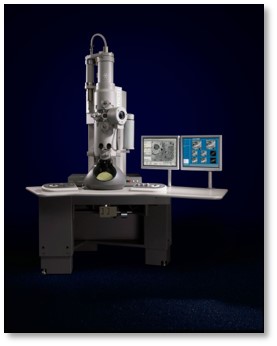 Model: Tecnai Spirit / Image courtesy: FEI Company |
- Image processing
Image processing
| Startup model | Type of model: NONE |
|---|---|
| Final reconstruction | Resolution.type: BY AUTHOR / Resolution: 3.07 Å / Resolution method: FSC 0.143 CUT-OFF / Number images used: 255110 |
| Initial angle assignment | Type: MAXIMUM LIKELIHOOD |
| Final angle assignment | Type: MAXIMUM LIKELIHOOD |
 Movie
Movie Controller
Controller




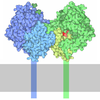


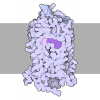
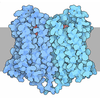



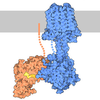
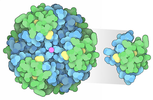




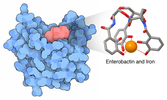

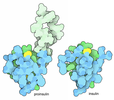
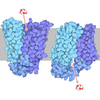



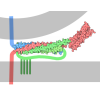
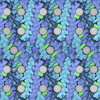
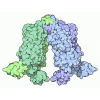
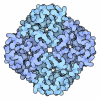
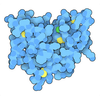




 Z (Sec.)
Z (Sec.) Y (Row.)
Y (Row.) X (Col.)
X (Col.)




































